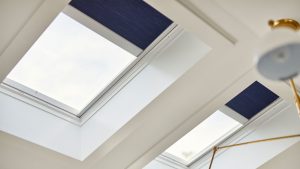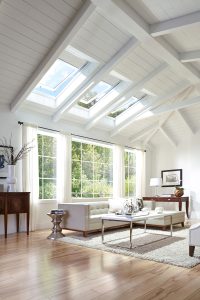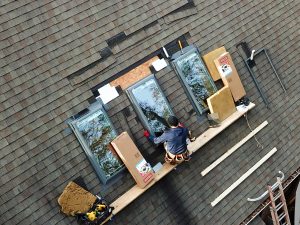
Just like vertical windows, skylights have an average lifespan of about 30 years before they need to be replaced. The key to making sure your skylight will last as long as possible is making sure it was properly installed and sourced from a credible skylight manufacturer.
How to Get the Most Out of Your Skylight
In general, skylights don’t require a ton of maintenance, but there are a few things you can do to make sure they last as long as possible.
- Make sure you purchase your skylight from a reputable manufacturer. Be sure to reach out to your local roofer or contractor for recommendations on quality skylight manufacturers. You can also check out your local building supply store such as Lowes or Home Depot to find out which skylight works best for you.
- Have your skylight installed by a certified skylight installer. Not only will this make sure your skylight will last for a long time, but often skylight manufacturers won’t let you capitalize on any product warranties unless it was installed properly by a professional.
- Cleaning your skylight inside and out with soap and water using a soft cloth is great for your skylight. It won’t necessarily extend the life of your skylight but rather make sure it is performing at its best for as long as possible.
Who Replaces a Skylight?
Typically, there are three different avenues you can take when deciding who is going to pay for replacing your skylight. All of which depend on how it was damaged and purchased.
Insurance Company
Your homeowner’s insurance policy usually treats a skylight as part of the roof. When the roof is damaged due to hail, debris, or any other environmental damage, your HOI will likely cover the cost of the damage incurred. Keep in mind HOI policies vary across the board. It is important to check the terms and conditions of your individual policy to see if your skylight is covered.
Skylight Manufacturer
The skylight manufacturer that you purchased your skylight through will be able to replace your skylight if it falls under a certain warranty that the manufacturer offers. For example, some skylight companies will have warranties that cover leaks, damage caused by weather, or a defective skylight. To qualify for these warranties and have your skylight replaced at no cost to you, your skylight must be purchased from the manufacturer or a certified dealer, and it must be installed properly by a certified installer. The skylight manufacturer will almost always cover any damage caused by a defective product.
Yourself
You will have to cover the cost to replace your damaged skylight if you do not meet the requirements specified by the manufacturer’s warranty or your HOI policy. For example, if you installed the skylight improperly yourself or had an unauthorized contractor install it and it begins to leak after a year, you are likely on the hook for the cost to replace the skylight. Be sure to check your HOI policy as well as what warranties are offered before buying and installing your skylight.
Factors That Can Affect the Lifespan of a Skylight
While the list is short, there are a few things that can affect the lifespan of your skylight that may or may not be in your control.
- Strong winds or hail caused by inclement weather can bring about large debris that could damage your skylight. Modern skylights are typically equipped to deal with this as they are built with strong laminated glass designed to spiderweb when it breaks rather than shattering into tiny pieces.
- Lack of care and maintenance can shorten your skylight’s lifespan. While minimal care is needed for your skylight it is important to keep an eye on it for any cracks or scratches early before they develop into something more.
- Replacing your roof without replacing your skylight. It is best to get both replaced at the same time to minimize damage to your skylight caused by the amount of movement and displacement of the shingles around the skylight. This could cause leaks in the future.






